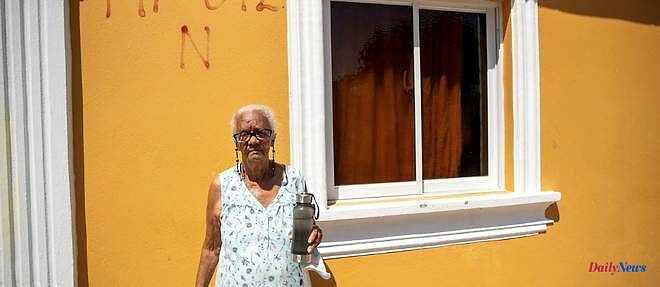A board bearing the red inscription "MF 011-5" lies on the ground, where a few months ago Leocadio Guzman's house stood, razed to make way for the anti-immigration wall being built between the Dominican Republic and its much poorer neighbour, Haiti.
"MF" as "border wall", think the locals. The one that Dominican President Luis Abinader launched with great fanfare in February 2022: a 160 km concrete fence along the 380 km border between the two countries.
Elected in 2020 on a program to fight against illegal immigration, he assures that this project will stop the flow of unwanted migrants and protect the country from Haitian gangs with growing influence.
The Dominican Republic welcomes some 500,000 Haitians in search of better living conditions in this much more prosperous country and regularly expels thousands of illegal immigrants (171,000 in 2022). Relations between the two neighbors of the island of Hispaniola are tense.
Part of the La Mara slum in the northwestern border province of Dajabon was destroyed three months ago by bulldozers that left the remains of concrete foundations, some planks and sheets.
Thirty families were evicted. About fifty others seem destined for the same fate in the neighboring province of Monte Cristi. Their houses are marked with the red "MF" seal. The government has declared these properties of public utility.
The Ministry of Defense, responsible for the works, announced in November the payment of 79 million pesos (1.4 million dollars) in compensation for these expropriations and expulsions.
But among the displaced, a complaint comes up like a litany: the compensation is too low.
"The money they gave me is not enough," protested Lidna Dorfinis, 38, a Haitian resident of La Mara, carrying a one-year-old girl in her arms. "The authorities have given no support (besides compensation) and now I live alone," she adds in Creole.
She received 250,000 pesos ($4,500), which is barely enough to buy a piece of land without a house. Financially unable to build, she now pays rent of $60 a month. A considerable sum for her.
Leocadio, who is Dominican, received less money, around 4,200 dollars, but came out of it better because he had anticipated the events.
Last year, he had heard "the rumor" that the government was going to demolish houses near the Massacre River - the natural border - and had started building a new house on land nearby.
"At least I have a place to lay my head," he consoles himself today.
The mayor of Dajabon, Santiago Riveron, assures that the authorities did what was necessary: "it was not traumatic", he affirms because there were negotiations between the State and the expropriated.
Leocadio, 41, who had moved into the house with his pregnant wife, sees things differently, deeming the negotiation "unequal", in which the inhabitants had "everything to lose".
"I was not very satisfied but I had to accept," he said among the chickens in his new home.
Nearby, on the pink walls of the house of Quisqueya Estevez, 36, a red inscription "MF-032". The house is still standing but only partially. The one where the bathroom was located gave way after a landslide caused by construction work on the wall. She says she has not been compensated and has to do her "needs in a bucket". "I feel very bad," she laments.
In the workers' sector of Pepillo Salcedo, in Monte Cristi, many houses are also condemned to destruction.
More elaborate and therefore more expensive than those of La Mara, the State offers compensation seven times higher. But there, too, discontent rumbles.
"If they want to get rid of us, let them do it for something worthwhile. If not, leave us alone," protested Dominga, 41, who lives there with his 72-year-old mother and two teenagers. "I came here as a baby. I was crawling. Starting over will be very difficult."
03/24/2023 13:09:47 - Dajabón (Dominican Republic) (AFP) - © 2023 AFP












